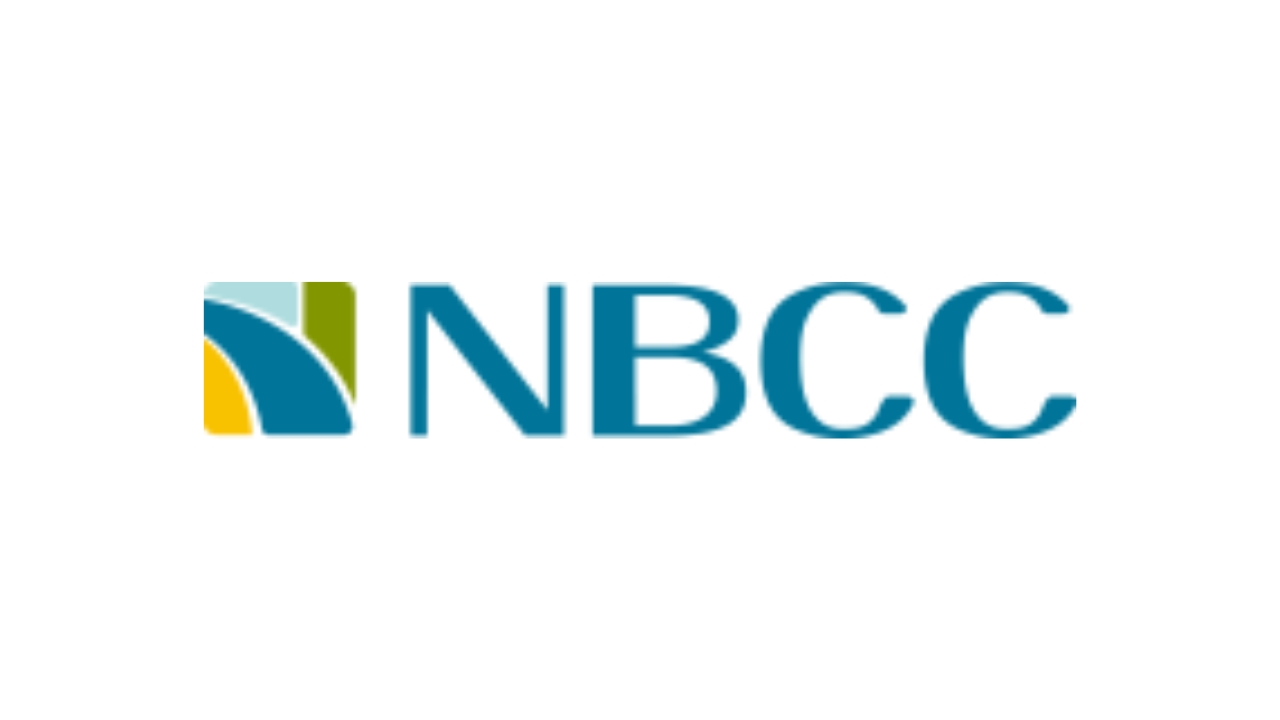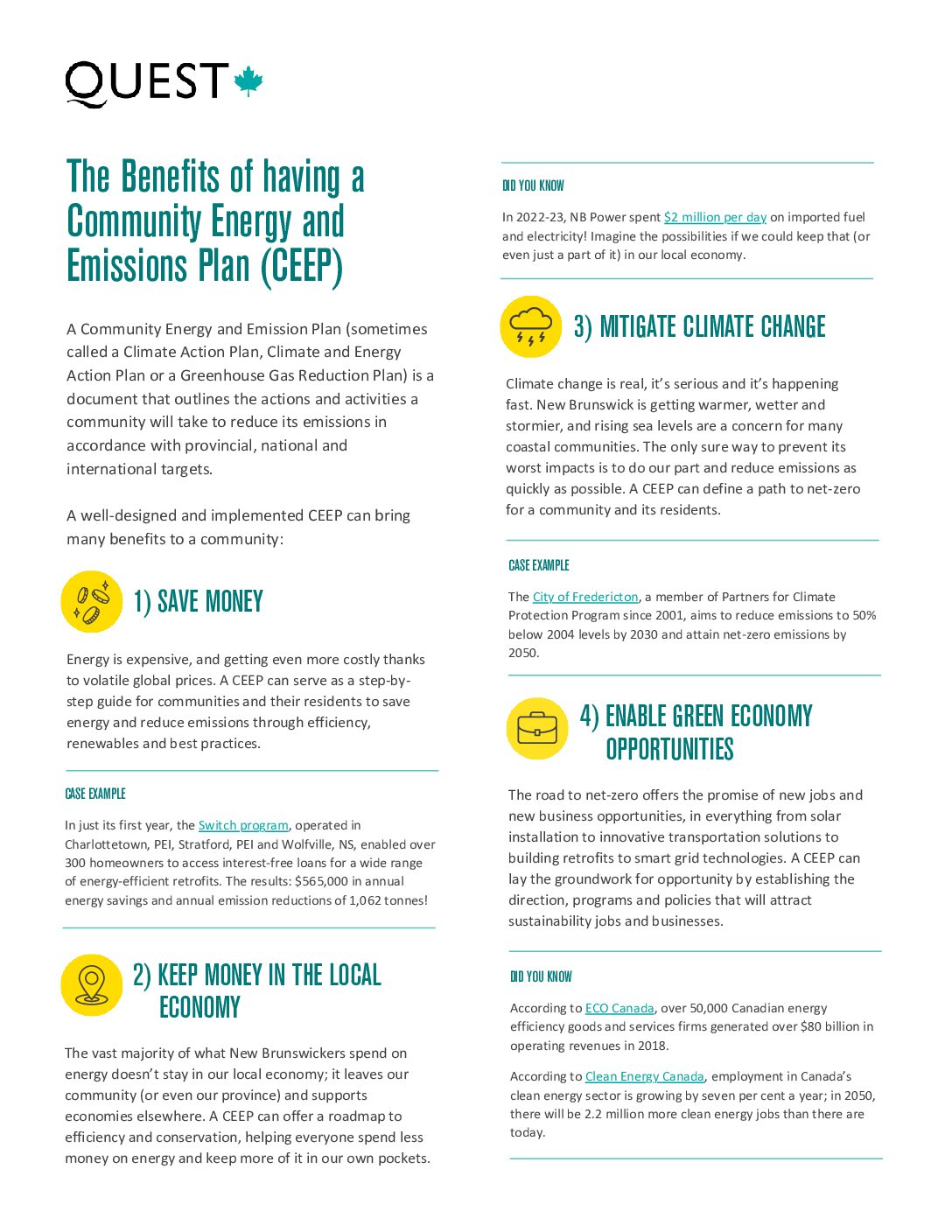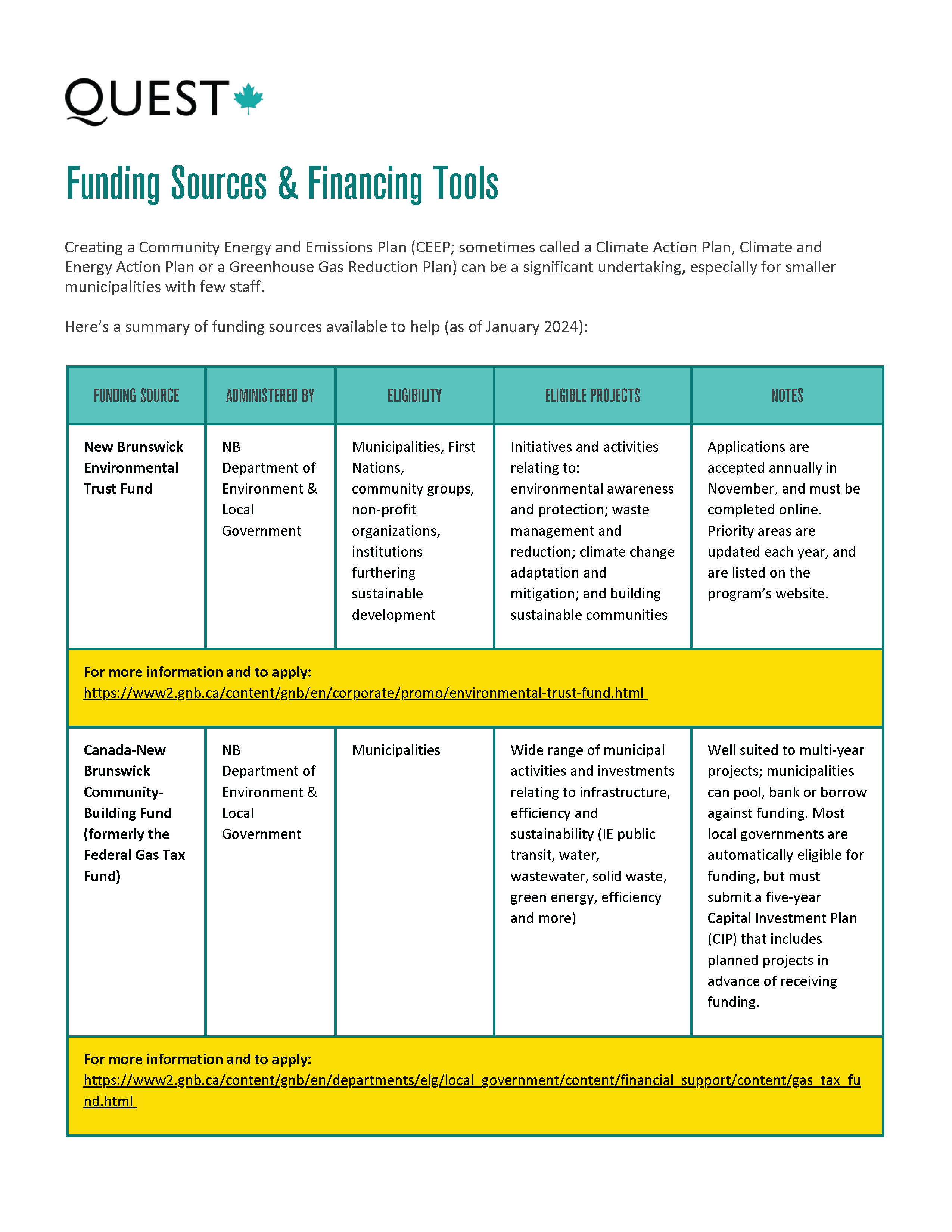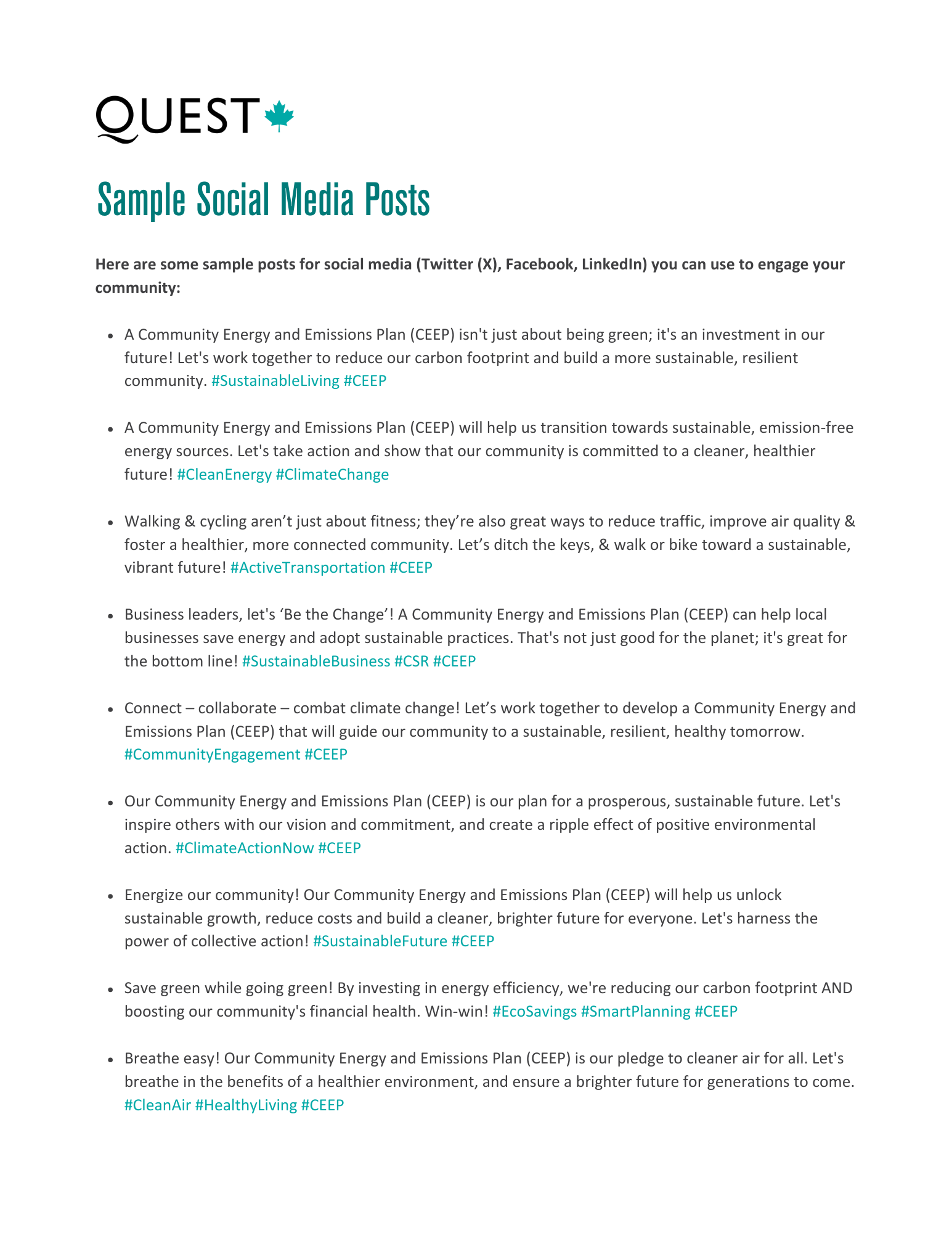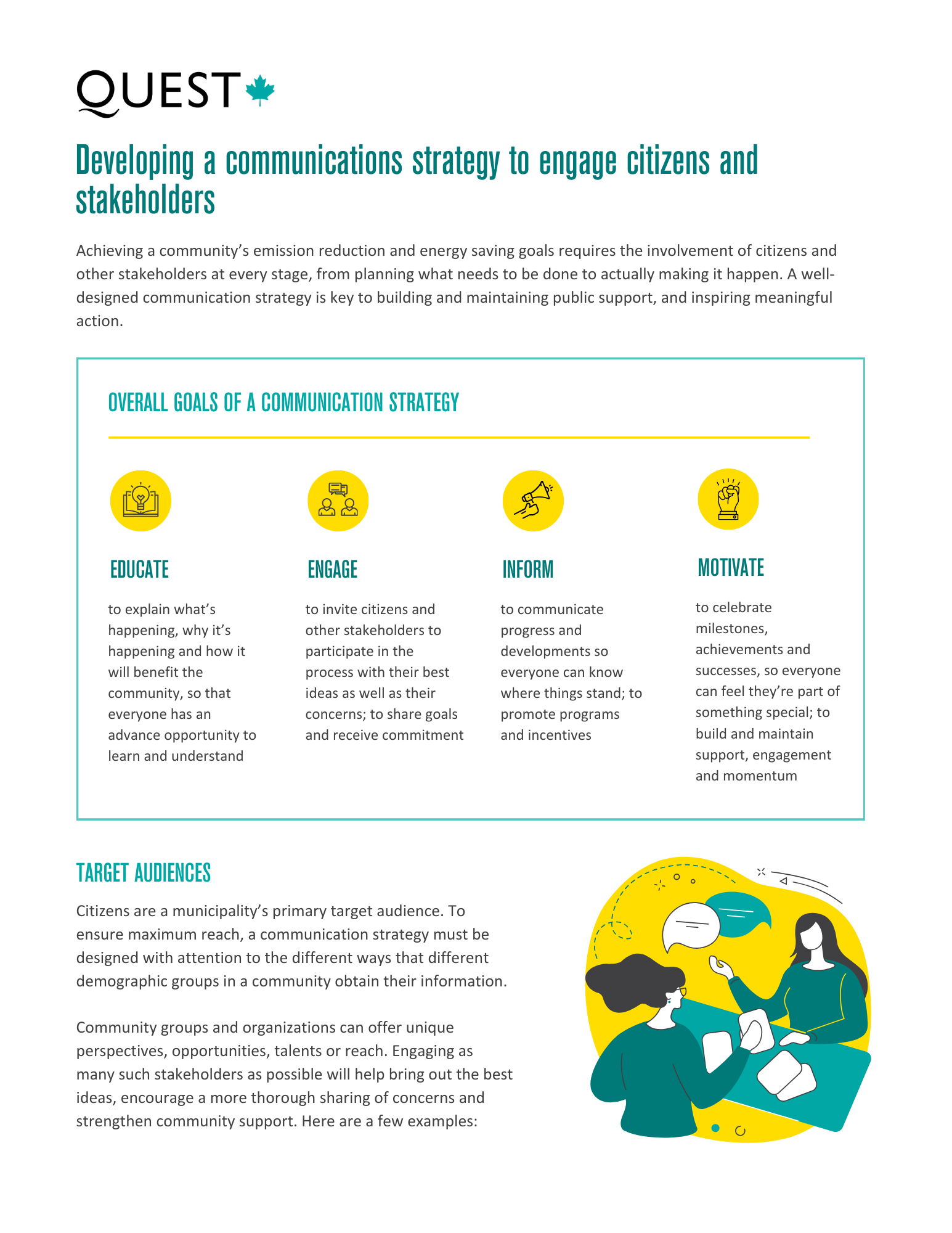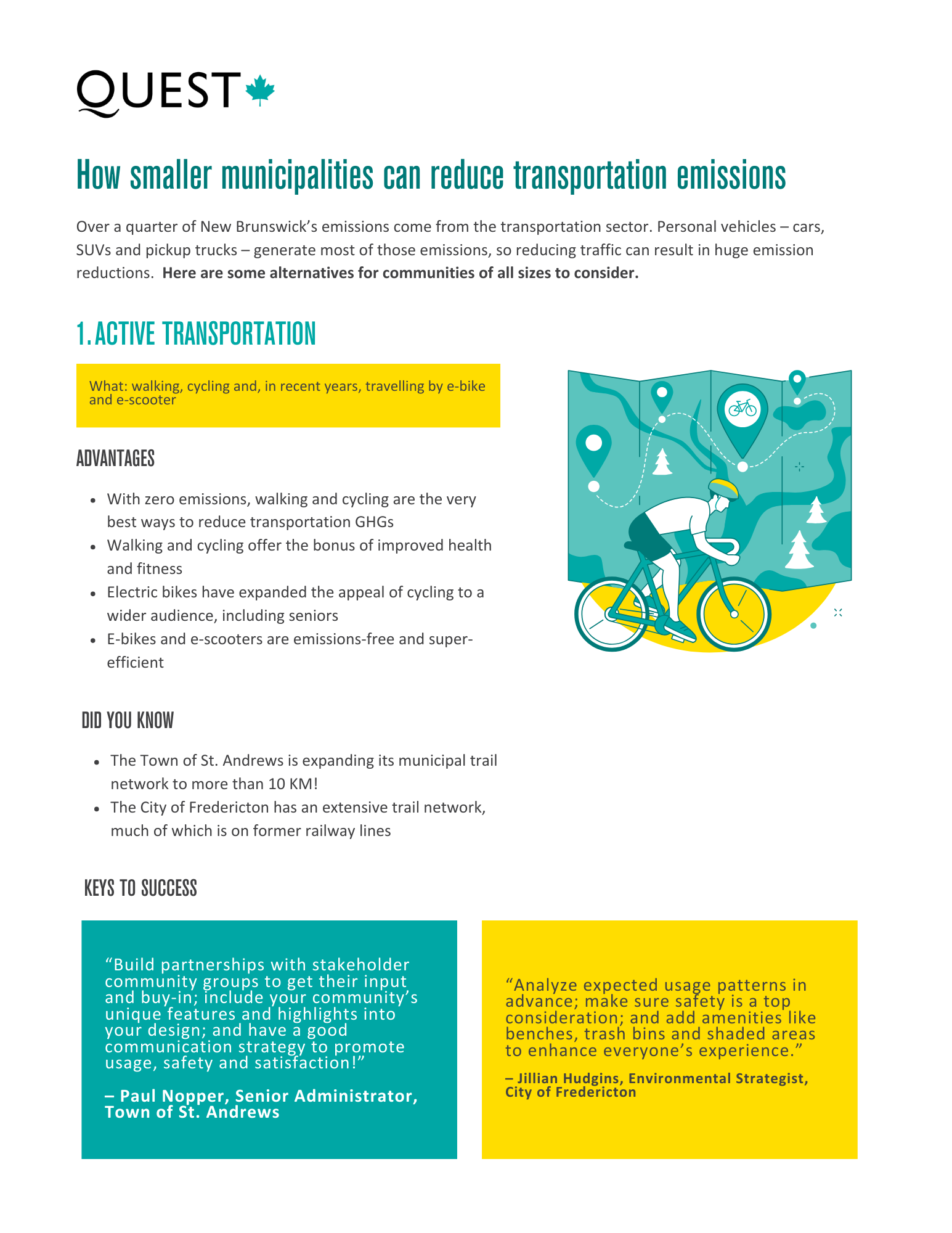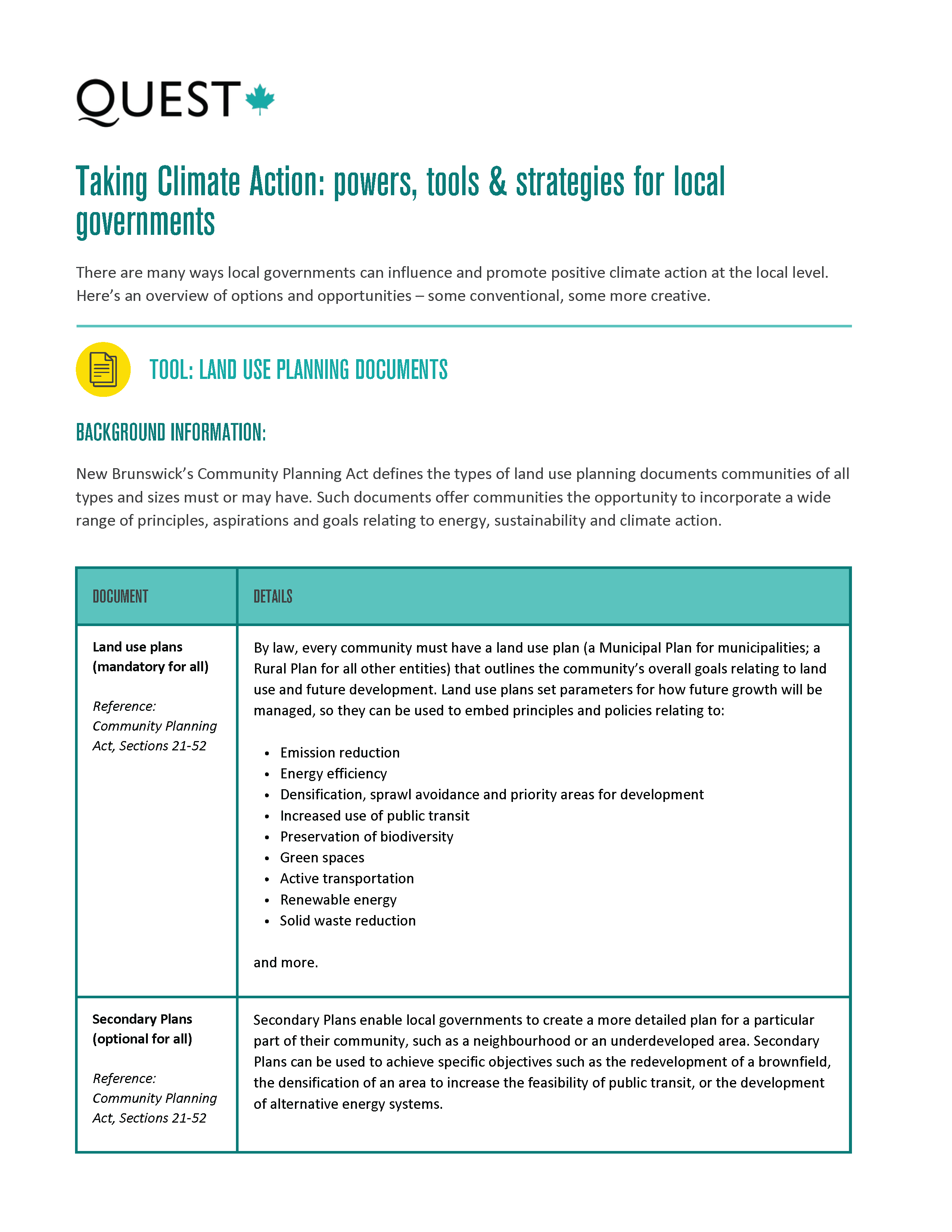New Brunswick
Community Energy and Emission Planning Resource Hub
Climate change: it’s serious, it’s urgent and it requires action.
Emissions from human activities are causing extreme weather, flooding, forest fires and more.
Solutions are needed, and communities everywhere have a big role to play. In fact, the NB Climate Change Action Plan aims that all New Brunswick local governments begin reporting their emissions by 2025, and have a GHG Reduction Plan / Community Energy and Emission Plan (CEEP) in place by 2030.
But where to begin?
Right here! If you’re an NB municipal leader or official, you’ll find everything you need to create a CEEP for your community: from developing a vision to setting targets to implementation and reporting. Plus you’ll find links to resources to support and guide you; case examples and best practices; and funding programs.
What's a CEEP?
A Community Energy and Emission Plan (sometimes called a Climate Action Plan, Climate and Energy Action Plan or a Greenhouse Gas Reduction Plan) is a document that outlines in detail how a community intends to reduce its greenhouse gas emissions in accordance with provincial, national and international targets. A CEEP:

Benefits of having a CEEP
Save money
reduced energy consumption means lower bills for everyone
Keep money in the local economy
instead of spending it on imported energy
Mitigate climate change
by articulating a clear path to lower emissions
Build community resilience
so citizens are prepared for the impacts of climate change
Promote greater self-reliance and energy security
through efficiency and renewables
Improve public health
by encouraging more active transportation like walking and biking
Attract new residents and businesses
seeking a community compatible with their values and Environmental and Sustainability Goals
Access more funding
having a CEEP makes it easier for municipalities to access more financial support programs
Enable green economy opportunities
for local businesses in energy efficiency, renewable energy and more
Environmental benefits
protected green spaces and cleaner air, water and soil contribute to healthier ecosystems
New Brunswick’s 2022-27 Climate Change Action Plan encourages all NB local governments to have as GHG Reduction plan or CEEP by 2030.
How to create a CEEP – the five key steps

Step One: Establish a baseline or ‘inventory’
Gather and compile your community’s most recent energy and emissions data. Include energy and emissions relating to transportation, buildings of all types, industry, agriculture, municipal services and waste. This becomes your baseline, against which all progress will be measured. As well, develop a ‘business as usual’ forecast for 10 years beyond your baseline, factoring in expected community growth and expansion.

Step Two: Set emissions reduction targets
Establish specific targets that indicate by what percentage emissions will be reduced from the baseline by a specific future target year. Targets should be ambitious and inspiring, but realistic and achievable. They should be developed in consultation with all stakeholders, and endorsed by Council. In smaller municipalities, a single, all-encompassing target may be sufficient; in larger municipalities, sector-by-sector targets may be more useful.

Step Three: Develop a plan
Identify and prioritize the actions and activities that will be undertaken to achieve your community’s emission reduction targets, and estimate what emission reductions are anticipated for each (if possible). Involve and engage as many stakeholders as possible, and look to other communities for effective ideas and strategies. Identify and assign the funding and other resources needed. Aim for a few early successes, to maintain support and build momentum. Ensure long-term continuity by embedding actions and activities into other municipal documents like budgets, land use plans, strategic plans, bylaws, policies, processes and job descriptions.

Step Four: Implement the plan
Designate the leader and team responsible for executing your plan. Develop an implementation schedule detailing what will be done by whom and by when. Allocate budgets, and seek additional funding from external programs and sources. Involve and engage as many people, partners and organizations as possible. Anticipate and overcome hurdles, and modify your plan as needed. Present progress reports to maintain public interest and Council support.

Step Five: Monitor, measure, report, adjust
Measure the impacts of each action taken, and compare the results to your targets. Analyze what’s happening, and make adjustments where necessary. Share notable initiatives and success stories with Council, citizens, funders and other stakeholders. Report your results on the Department of Environment and Local Government’s new portal (coming soon), and consider modifying your targets where appropriate.
Funding sources & financing tools
External funding sources
New Brunswick Environmental Trust Fund
Administered by
NB Department of Environment & Local Government
Eligibility
- Municipalities
- First Nations
- Community groups
- Non-profits
Eligible projects
- Climate change
- Sustainability
- Waste reduction
- Environmental preservation
Notes
Applications accepted annually in November
Website
https://www2.gnb.ca/content/gnb/en/corporate/promo/environmental-trust-fund.html
Community Development Fund
Administered by
NB Regional Development Corporation
Eligibility
- Municipalities
- RSCs
- First Nations
- Non-profits
Eligible projects
Can support capital projects / infrastructure projects
Notes
No deadline. Contact: RDC-SDR@gnb.ca
(506) 453-2277
Website
Canada-New Brunswick Community-Building Fund
(formerly the Federal Gas Tax Fund)
Administered by
NB Department of Environment & Local Government
Eligibility
- Municipalities
Eligible projects
Sustainable infrastructure such as public transit, water, wastewater and green energy
Notes
Well suited to multi-year projects; municipalities can pool, bank or borrow against funding
Website
Green Municipal Fund
Administered by
Federation of Canadian Municipalities
Eligibility
- Municipalities and partnering private sector entities
- Not-for-profits
- Indigenous communities
Eligible projects
Wide range of sustainability projects in five priority sectors:
- Energy
- Waste
- Transportation
- Land use
- Water
Notes
Pre-application is required to confirm eligibility of a project.
Website
Federal infrastructure programs and services
Administered by
Infrastructure Canada
Eligibility
- Municipalities and other entities
Eligible projects
Slate of funds supporting sustainable transportation, buildings and more
Notes
Constantly evolving funding opportunities; check regularly
Website
Environment and Climate Change Canada funding programs
Administered by
Environment & Climate Change Canada
Eligibility
- Municipalities
- Groups
- Organizations
- Individuals
Eligible projects
Slate of funds and programs supporting:
- Climate change action
- Species at risk protection
- Waste reduction and more
Notes
Constantly evolving funding opportunities; check regularly
Website
https://www.canada.ca/en/environment-climate-change/services/environmental-funding.html
Natural Resources Canada funding opportunities
Administered by
Natural Resources Canada
Eligibility
- Municipalities and other entities
Eligible projects
Slate of funds and programs supporting:
- Efficiency
- Resilience
- Green energy and more
Notes
Constantly evolving funding opportunities; check regularly
Website
Commercial Buildings Retrofit Program
Administered by
NB Power
Eligibility
- Municipal buildings
Eligible projects
Wide range of energy efficiency upgrades
Website
https://www.saveenergynb.ca/en/for-business/commercial-buildings-retrofit-program/
Business Rebate Program
Administered by
NB Power
Eligibility
Municipal buildings classified as Small Industrial, General Service 1, or General Service 2 Rate Schedule under NB Power’s Rate Schedules and Policies
Eligible projects
Wide range of energy efficiency upgrades
Website
https://www.saveenergynb.ca/en/for-business/business-rebate-program/
Financing tools and options available to municipalities
The costs of small energy-saving and emission-reduction projects and activities can often be incorporated into a municipality’s annual budget. However, larger and multi-year projects may require financing. Here are mechanisms available to municipalities:
- Obtaining grants and loans from fund providers, such as the Green Municipal Fund for more favourable interest rates
- Borrowing via conventional channels
- Borrowing from pension funds for mutual benefit
- Issuing municipal green bonds, with proceeds earmarked for specific sustainability projects
- Establishing a revolving fund, where savings generated from initial projects supported are used to continuously finance new projects
- Entering into energy performance contracts (also called energy service performance contracts), where projects are financed entirely by the energy savings they generate
- Establishing user fees on utilities and other services to finance specific projects and upgrades
- Realigning development cost charges to favour sustainability and efficiency in all new construction
- Offering tax increment financing and other tax incentives to encourage revitalization of designated zones or areas
- Partnering with community groups, neighbouring communities, First Nations and private entities on projects such as renewable energy
- Offering local improvement charge financing to enable building owners to do efficiency upgrades with little to no upfront cost
- Including a surcharge on property taxes to raise funds for capital projects
Resources to help
You don’t have to go it alone – or reinvent the wheel! Here are leading organizations and resources to help:
QUEST Canada
Not-for-profit / registered Canadian charity that helps communities plan, prepare and implement CEEPs
How it can help
- Administers the Net-Zero Communities Accelerator (NCA) program, a step-by-step process to help communities plan, prepare and implement CEEPs
- As part of the NCA, offers energy mapping workshops, community energy planning support, resilience workshops and one-on-one coaching services to municipalities
- Offer tools, templates and other resources to simplify CEEP planning and implementation
- Consult QUEST’s information sheets on topics such as: How to Develop a CEEP; Funding; Municipal Powers and Tools for GHG reduction; Behaviour change and community engagement methods; etc.
Website

Net-Zero Communities Accelerator Program
Type of organization
The Net-Zero Communities Accelerator (NCA) program leverages proven tools and services, equipping participating communities with the knowledge necessary to develop and continuously implement community energy and emissions plans (CEEPs).
How it can help
- The program provides a robust suite of resources and guidance, enabling communities to attain the economic, environmental, and social benefits associated with their CEEPs
- What makes the NCA program distinct is its prioritization of integrated CEEPs, including all relevant stakeholders, its inclusivity of communities of all sizes, and its adaptability to the unique context of each participating community.
- The program introduces communities to new ways of thinking and working, supporting them on their pathway to net-zero.
Website
Federation of Canadian Municipalities (FCM)
Type of organization
Advocacy group representing over 2,000 Canadian municipalities
How it can help
- Administers the substantial and comprehensive Green Municipal Fund (GMF)
- Together with ICLEI, administers Partners for Climate Protection (PCP), the five-step process to developing a CEEP
- Offers technical expertise and guidance in areas such as data collection, analysis and reporting
- Offers training and capacity building
- Provides case examples of successful projects and policies
Website
ICLEI – Local Governments for Sustainability
Type of organization
International NGO promoting sustainable development in 125+ countries
How it can help
- Together with FCM, administers Partners for Climate Protection (PCP), the five-step process to developing a CEEP
- Provides vetting and validation of milestones and progress
- Offers a wide range of tools, templates and resources, including for measuring and reporting emissions inventories
- Offers training, technical support and assistance
Website
Efficiency Canada
National NGO advocating the economic and environmental benefits of energy efficiency
How it can help
- Conducts research and publishes reports on the benefits, potential and payback of a wide range of energy efficiency technologies, strategies and policies
- Offers templates of building codes, bylaws and policies
- Maintains a database of energy efficiency policies in jurisdictions across Canada
- Offers expert support for municipalities seeking to enact efficiency codes, bylaws and policies
Website
NB Department of Environment and Local Government
Type of organization
Provincial Government Department
How it can help
- Administers the Environmental Trust Fund
- Publishes and updates New Brunswick’s Climate Action Plan
- Provides data and maps relating to anticipated climate change impacts such as higher temperatures, extreme rainfall events, flooding and sea level rise
- Offers extensive resources relating to energy, emissions, adaptation and resilience
- Provides case studies from New Brunswick municipalities
- COMING SOON: Hosts an online portal where municipalities can file CEEPs and annual updates
Website
Environment and Climate Change Canada
Type of organization
Federal Government Department
How it can help
- Provides data on energy consumption and the emission intensity of electricity grids in Canadian provinces and territories
- Provides data and maps relating to anticipated climate change impacts such as temperature increases and changes in precipitation patterns
Website
Sustainable Solutions Group
Type of organization
Co-operative climate change consultancy
How it can help
- Administers MEED, the Municipal Energy & Emissions Database, a source of baseline energy and emissions data for communities across Canada
- Offers assistance in the development and implementation of climate mitigation and adaptation plans
- Offers expertise in modelling energy, emissions, financial and land use scenarios
Website
ClimAtlantic
Type of organization
Partnership between Atlantic Canada’s provincial governments and several environmental non-profits
How it can help
- Offers climate information and data in support of climate adaptation planning
- Offers expertise encompassing social, economic and environmental impacts of climate change
Website
Atlantica Centre for Energy
Type of organization
Non-profit organization that focuses on energy opportunities in Atlantic Canada
How it can help
- Provides accessible, accurate and reliable information on important current energy topics
- Participates in conferences and events as speakers, panel members and moderators; publish discussion papers and commentaries; and coordinate events and discussions
- Connects stakeholders and provides networking opportunities
Website
Smart Grid Innovation Network
Type of organization
National organization of leaders in the Canadian smart energy sector
How it can help
- Offers benchmarking, industry reports trade mission planning and delivery , community engagement, leadership forums, workshops and conferences to support to industry, government and academia
- Provides product and technology support, market and trade development support, networking and B2B marketing, sector experience and research support
Website
New Brunswick Community College
Type of organization
Community College
How it can help
- Can be a source of graduate and post-graduate students to help communities implement CEEPs
Website
Success stories
Looking for ideas? Here are examples of successful actions and best practices from communities across the region and beyond to inspire you!
CEEP information sheets
Get started today!
Ready to take those first steps? Depending on the size of your municipality, here are options to consider:
Join the QUEST Accelerator program
for coaching, guidance and support from start to finish
Do it in house
assign regular staff, assisted by students, interns or contract employees
Hire someone
many commercial firms (IE engineering and accounting firms; energy and environmental consultants) have expertise
Hire a local non-profit
such as ACAP Saint John, Eastern Charlotte Waterways, Nashwaak Watershed Association or EOS Eco-energy
Contact your municipal Association
such as AFMNB, AMANB, UMNB











